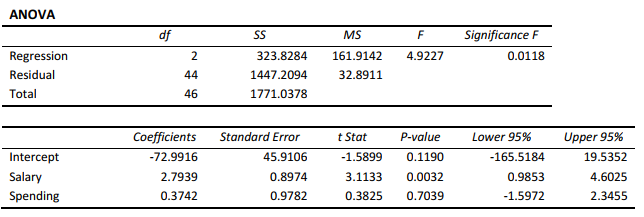SCENARIO 14-15
The superintendent of a school district wanted to predict the percentage of students passing a sixthgrade proficiency test. She obtained the data on percentage of students passing the proficiency test (% Passing) , mean teacher salary in thousands of dollars (Salaries) , and instructional spending per pupil in thousands of dollars (Spending) of 47 schools in the state.
Following is the multiple regression output with Y = % Passing as the dependent variable, X1 = Salaries and X 2 = Spending:

-Referring to Scenario 14-15,which of the following is a correct statement?
Definitions:
Attorney
A professional who is qualified to offer advice about the law or represent someone in legal matters.
Age at Retirement
The specific age at which an individual ceases full-time work and formally enters retirement, varying by personal choice, company policy, or statutory requirements.
Joint Frequency Distribution
A statistical method that shows the frequency of two variables occurring simultaneously within a dataset, often visualized in a table format.
Longest Run
The longest sequence of consecutive occurrences of a given outcome in a series of trials or observations.
Q3: Referring to Scenario 12-12,if the null hypothesis
Q31: Referring to Scenario 13-10,construct a 95% confidence
Q46: Referring to Scenario 16-12,to obtain a fitted
Q62: Referring to Scenario 17-3,what percentage of the
Q75: Referring to Scenario 17-4,the highest mean weekend
Q139: Referring to Scenario 16-12,to obtain the fitted
Q144: Referring to Scenario 13-12,what percentage of the
Q168: Referring to Scenario 14-15,which of the following
Q175: A researcher randomly sampled 30 graduates,18 males
Q308: A professor of economics at a small